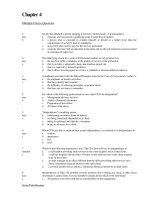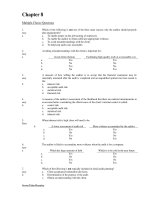Lecture Auditing and assurance services (Second international edition) Chapter 5 Audit planning and types of audit tests
Bạn đang xem bản rút gọn của tài liệu. Xem và tải ngay bản đầy đủ của tài liệu tại đây (915.62 KB, 42 trang )
Chapter Five
Audit Planning
and
Types of Audit Tests
McGraw-Hill/Irwin
© The McGraw-Hill Companies 2010
The Phases of an Audit
That Relate to Audit Planning
McGraw-Hill/Irwin
© The McGraw-Hill Companies 2010
Prospective Client Acceptance
1. Obtain and review financial information.
2. Inquire of third parties.
3. Communicate with the predecessor
auditor.
4. Consider unusual business or audit
risks.
5. Determine if the firm is independent.
6. Determine if the firm has the necessary
skills and knowledge.
7. Determine if acceptance violates any
applicable regulatory or ethical
requirements.
McGraw-Hill/Irwin
© The McGraw-Hill Companies 2010
Continuing Client Retention
Evaluate client retention
periodically
Near audit completion or
after a significant event
Conflicts over
accounting & auditing
issues
McGraw-Hill/Irwin
© The McGraw-Hill Companies 2010
Dispute over fees
Establish Terms of the Engagement
In establishing the terms of the engagement,
three topics must be discussed:
1.The engagement letter.
2.The internal auditors.
3.Those charged with governance.
The terms of the engagement, which are
documented in the engagement letter, should
include the objectives of the engagement,
management’s responsibilities, the auditor’s
responsibilities, and the limitations of the
engagement.
McGraw-Hill/Irwin
© The McGraw-Hill Companies 2010
The Engagement Letter
The engagement letter formalises the arrangement
reached between the auditor and the client.
In addition to the items mentioned in the sample
engagement letter in Exhibit 5-1 in the textbook,
the engagement letter may include:
• Arrangements for use of experts or
internal auditors.
• Any limitations of liability of the auditor
or client.
• Additional services to be provided.
•Arrangements regarding other services.
McGraw-Hill/Irwin
© The McGraw-Hill Companies 2010
Internal Auditors
McGraw-Hill/Irwin
© The McGraw-Hill Companies 2010
Those Charged with Governance
Board of Directors
Audit Committee
McGraw-Hill/Irwin
© The McGraw-Hill Companies 2010
Preliminary Engagement Activities
Determine the Audit
Engagement Team
Requirements
Assess Compliance with
Ethical Requirements,
including Independence
McGraw-Hill/Irwin
© The McGraw-Hill Companies 2010
Planning the Audit
• The auditor will develop an overall audit strategy
for conducting the audit. This will help the auditor
to determine what resources are needed to perform
the engagement.
• An audit plan is more detailed than the audit
strategy.
• Basically, the audit plan should consider how to
conduct the engagement in an effective and
efficient manner.
McGraw-Hill/Irwin
© The McGraw-Hill Companies 2010
Planning the Audit
When preparing the audit plan, the auditor should be
guided by the results of the risk assessment procedures
performed to gain an understanding of the entity.
Additional steps:
•Assess business risks and
establish materiality.
• Assess the need for experts.
•Consider the possibility of noncompliance (illegal) acts.
•Identify related parties.
•Conduct preliminary analytical
procedures.
•Consider additional value-added
services.
McGraw-Hill/Irwin
© The McGraw-Hill Companies 2010
Let’s look at
each
of these steps.
Assess Risks and Establish Materiality
Assess
Risks
Use audit
risk model
Restrict risk at
account
balance level
Establish
Materiality
Achieve
acceptable
low level of
audit risk
You may want to review the detailed discussion in
Chapter 3 of the process used to assess the client’s
business risks and to establish materiality.
McGraw-Hill/Irwin
© The McGraw-Hill Companies 2010
Experts
A major consideration in planning the audit is the
need for an auditor’s expert (ISA 620).
The use of an IT expert
is a significant aspect of
most audit
engagements.
The presence of complex
information technology
may require the use of an
IT expert.
McGraw-Hill/Irwin
© The McGraw-Hill Companies 2010
Non-Compliance (Illegal) Acts
Non-Compliance Acts
McGraw-Hill/Irwin
Direct &
Material
Material &
Indirect
Consider laws and
regulations as part
of audit
Be aware may have
occurred;
investigate if
brought to attention
© The McGraw-Hill Companies 2010
Non-Compliance Acts
McGraw-Hill/Irwin
© The McGraw-Hill Companies 2010
Related Parties
Some examples from IAS 24 Related
Party Disclosure
Related Parties
•Parents and subsidiaries.
•Significant influence.
•Joint control.
•Associate entity.
•Joint venture.
•Management.
•Close family of the
•Review minutes of meetings of boards
•Other parties that can have
•Review significant contracts and
principal owners & management.
significant influence.
McGraw-Hill/Irwin
How to Identify
© The McGraw-Hill Companies 2010
and management.
•Review conflict of interest
statements.
•Review records of the entity’s
investments.
•Review contracts and agreements with
key management or those charged with
governance.
agreements not in the entity’s ordinary
course of business.
Preliminary Analytical Procedures
To understand the
client’s business
and transactions
To identify
financial statement
accounts likely to
contain errors
By understanding the client’s business and
identifying where errors are likely to occur, the
auditor can allocate more resources to investigate
necessary accounts.
McGraw-Hill/Irwin
© The McGraw-Hill Companies 2010
Additional Value-Added Services
Tax Planning
Internal
reporting
Transaction
Support
ITconsultancy
Benchmarking
Risk
Assessment
Auditors are limited in the types of
consulting services that they can offer
their audit clients.
McGraw-Hill/Irwin
© The McGraw-Hill Companies 2010
Document Overall Audit Strategy and
Audit Plan
Document overall audit
strategy and audit plan, which
involves documenting the
decisions about
A
The auditor documents how the client
is managing its risk (via internal
control processes) and the effects of
the risks and controls on the planned
audit procedures.
U
D
Nature
I
T
T
Timing
E
S
Auditors ensure they have addressed the risks they
identified by documenting the linkage from the client’s
business, objectives, and strategy to the audit plan.
The auditor’s preliminary decision concerning control
risk determines the level of control testing, which in
turn affects the auditor’s substantive tests of the
account balances and transactions.
T
S
McGraw-Hill/Irwin
Extent
© The McGraw-Hill Companies 2010
Document Overall Audit Strategy and
Audit Plan
McGraw-Hill/Irwin
© The McGraw-Hill Companies 2010
Types of Audit Tests
McGraw-Hill/Irwin
Risk
Assessment
Procedures
Used to obtain an understanding of
the entity and its environment,
including internal control.
Tests of
Controls
Performed to obtain audit evidence
about the operating effectiveness
of controls in preventing, detecting
and correcting material
misstatements.
Substantive
Procedures
Detect material misstatements in a
transaction class, account balance,
and disclosure element of the
financial statements.
© The McGraw-Hill Companies 2010
Tests of Controls
Inquiry
Inspection
Observation
Walk
Through
McGraw-Hill/Irwin
© The McGraw-Hill Companies 2010
Reperformance
Tests of Controls
McGraw-Hill/Irwin
© The McGraw-Hill Companies 2010
Substantive Procedures
McGraw-Hill/Irwin
Tests of
Details
Analytical
Procedures
Tests for errors or
fraud in individual
transactions, account
balances, and
disclosures
Obtains evidence
about particular
assertions related to
account balances or
classes of
transactions
© The McGraw-Hill Companies 2010
Dual Purpose Tests
Tests of
Controls
Substantive
Tests
Dual
Purpose
Test
McGraw-Hill/Irwin
© The McGraw-Hill Companies 2010









